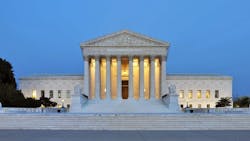SCOTUS limits power of federal government to regulate environmental, energy issues
The US Supreme Court curtailed the power of federal regulatory agencies, including those responsible for environmental and energy policy, in a series of decisions issued as its term ends.
The conservative court on June 28 struck down a 40-year-old precedent, known as the “Chevron deference,” that had required courts to yield to the “reasonable interpretations” of regulatory officials as they enforced ambiguous federal statutes.
The precedent, stemming from the 1984 case Chevron USA v. Natural Resources Defense Council, allowed agencies, like the Environmental Protection Agency (EPA), to argue that courts should defer to the regulators’ reading of statutes like the Clean Air Act and Clean Water Act – provided the interpretations are reasonable.
In its 6-3 ruling in Bright Enterprises v. Raimondo, the nation’s highest court reversed a lower court decision that cited “Chevron” as the rationale to uphold a National Oceanic and Atmospheric Administration mandate that herring vessels pay the salaries of onboard monitors who protect against overfishing.
With the ruling, courts will have more power to question regulatory agencies and their experts’ interpretation of statutes on everything from the environment to the financial markets and public health.
This could make it easier for petitioners to win legal challenges to climate-related EPA rules targeting emissions from power plants; oil, gas and pipeline infrastructure; and car and truck tailpipes.
SCOTUS blocks EPA enforcement of ‘good neighbor’ rule
The Supreme Court on June 27 also blocked the EPA’s ability to enforce a rule to limit pollution in about a dozen states until separate legal cases on the merits of the rule continue around the country. EPA’s “good neighbor” rule seeks to restrict emissions from power plants and other industrial sources that blow into other states and cause smog pollution.
Ohio, Indiana, West Virginia, as well as the gas pipeline, power, and steel industries challenged the rule, saying it was costly and could result in natural gas service disruptions.
The Interstate Natural Gas Association of America (INGAA) praised the court’s 5-4 ruling, noting that EPA failed to “consider the potential adverse impacts of the rule on natural gas reliability.” INGAA and other energy associations argue that the rule could force the shutdown of compressors and other pipeline infrastructure necessary to meet growing electricity demand. A US District Court in DC could decide on the merits of the good neighbor rule later this summer.
SEC ruling could make it difficult for EPA to fine rule breakers
The Supreme Court’s June 27 decision in SEC vs. Jarkesy could limit the ability of environmental and energy regulators to fine companies for violations of federal rules.
The court’s 6-3 ruling strips the SEC’s ability to use independent administrative law judges to conduct hearings, make factual findings and impose fines on those accused of securities fraud. ALJs are used by many agencies to enforce rules and penalize violators, including the EPA, the Pipeline and Hazardous Materials Safety Administration and others. The court’s decision could slow enforcement actions because budget-constrained federal agencies would have to bring alleged violators to court.
SCOTUS to hear case on scope of environmental reviews
The Court will have more opportunity to weigh in on federal environmental powers next term. The court said June 22 that it would hear a case related to the scope and speed of environmental reviews of infrastructure projects under the 1970 National Energy Policy Act.
Seven County Infrastructure Coalition v. Eagle County, Colo., involves a proposed 88-mile Uinta Basin Railway designed to move oil and minerals to markets in northeast Utah. The Surface Transportation Board (STB) approved the rail project. The US Court of Appeals for the DC Circuit reversed that decision in 2023, saying the agency failed to analyze the effects of increased drilling facilitated by the project or how a potential oil spill could affect wildlife and local communities.
Supporters of the rail project, including the Coalition, say those considerations lie outside the STB’s regulatory scope, and asked the Supreme court to clarify the powers and limits of the NEPA process.
About the Author
Cathy Landry
Washington Correspondent
Cathy Landry has worked over 20 years as a journalist, including 17 years as an energy reporter with Platts News Service (now S&P Global) in Washington and London.
She has served as a wire-service reporter, general news and sports reporter for local newspapers and a feature writer for association and company publications.
Cathy has deep public policy experience, having worked 15 years in Washington energy circles.
She earned a master’s degree in government from The Johns Hopkins University and studied newspaper journalism and psychology at Syracuse University.
